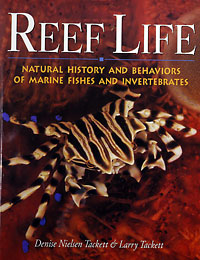Book Review: Reef Life

When Eric Cheng asked me to review Reef Life: Natural History and Behaviors of Marine Fish and Invertebrates (by Denise and Larry Tackett) I gladly accepted the task for two main reasons. First, I was very glad to see that a book about natural history and behavior of marine life was out, as there are not many books available on this subject. Second, I didn’t know about the book and didn’t have a copy! The main objective of the book is to simplify marine biology in a way that divers and aquarists can understand it, but still keep it scientifically accurate.
Reef Life is richly illustrated, 224 pages long, and is divided in 10 sections (a prologue, eight chapters and an epilogue). A very nice feature is that many underwater photographs are printed twice through the book: once in large size (full page or more) and a second time in small size with numbers linked to the main organisms in the photo, followed by a legend identifying the organisms, sometimes to family or genus, but many times to species.
The chapters range from Reef Origins (where the author gives a nice introduction about coral reefs, explaining in detail how they grow and what the main differences between coral reef types are) to Living Together (where they show and explain many examples of symbiotic relationships in the reef) to Reproduction (with detailed explanations of reproductive modes in reef organisms).
Feeding Time (chapter 5) is a nice account of feeding modes in the reef. Protection and Defense (chapter 6) describes in detail how reef organisms protect themselves from predation. The very detailed chapter on mimicry and camouflage (Masquerade) was especially interesting to me. This subject is fascinating and there are very few texts about it outside the scientific literature.
The epilogue (Disappearing Reefs), very appropriately deals with coral reef conservation, a subject that all divers should be very aware of. The main threats to the reefs are presented, and it certainly makes us wonder how long this wonderful habitat is going to last. The book ends on this subject, but I think that a positive spin in the end with successful examples of conservation efforts (like what is being done at the Great Barrier Reef), could have added a welcome optimistic view.
The only negative point I could find in the book was that some pictures apparently lack sharpness, contrast and saturation. This is the only copy I saw, so this may very well be an isolated problem. However, the scientific content of this book is so good that a few badly printed photos don’t stop me from considering it an excellent addition to the library of any underwater photographer or diver interested in learning more about live on a reef.